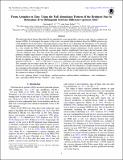From Actinides to Zinc: Using the Full Abundance Pattern of the Brightest Star in Reticulum II to Distinguish between Different
Author(s)
Ji, Alexander P.; Frebel, Anna L.
DownloadJi_2018_ApJ_856_138.pdf (2.213Mb)
PUBLISHER_POLICY
Publisher Policy
Article is made available in accordance with the publisher's policy and may be subject to US copyright law. Please refer to the publisher's site for terms of use.
Terms of use
Metadata
Show full item recordAbstract
The ultra-faint dwarf galaxy Reticulum II was enriched by a rare and prolific r-process event, such as a neutron star merger (NSM). To investigate the nature of this event, we present high-resolution Magellan/MIKE spectroscopy of the brightest star in this galaxy. The high signal-to-noise allows us to determine the abundances of 41 elements, including the radioactive actinide element Th and first ever detections of third r-process peak elements (Os and Ir) in a star outside the Milky Way. The observed neutron-capture element abundances closely match the solar r-process component, except for the first r-process peak, which is significantly lower than solar but matches other r-process enhanced stars. The ratio of the first peak to heavier r-process elements implies that the r-process site produces roughly equal masses of high and low electron fraction ejecta, within a factor of 2. We compare the detailed abundance pattern to predictions from nucleosynthesis calculations of NSMs and magnetorotationally driven jet supernovae, finding that nuclear physics uncertainties dominate over astrophysical uncertainties. We measure Th/Eu = -0.84 ± 0.06(stat) ± 0.22 (sys), somewhat lower than all previous Th/Eu observations. The youngest age we derive from this ratio is 21.7 ± 2.8 (stat) ± 10.3 (sys) Gyr, indicating that current initial production ratios do not describe the r-process event in Reticulum II. The abundances of light elements up to Zn are consistent with extremely metal-poor Milky Way halo stars. They may eventually provide a way to distinguish between NSMs and magnetorotationally driven jet supernovae, but this would require more detailed knowledge of the chemical evolution of Reticulum II.
Date issued
2018-04Department
Massachusetts Institute of Technology. Department of Physics; MIT Kavli Institute for Astrophysics and Space ResearchJournal
Astrophysical Journal
Publisher
American Astronomical Society
Citation
Ji, Alexander P. and Anna Frebel. “From Actinides to Zinc: Using the Full Abundance Pattern of the Brightest Star in Reticulum II to Distinguish Between Different r-Process Sites.” The Astrophysical Journal 856, 2 (April 2018): 138 © 2018 American Astronomical Society
Version: Final published version
ISSN
1538-4357
0004-637X